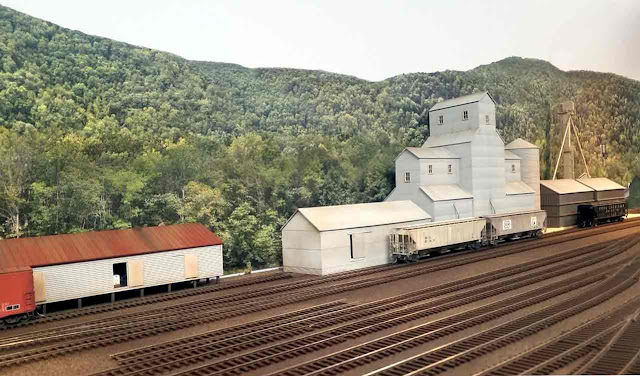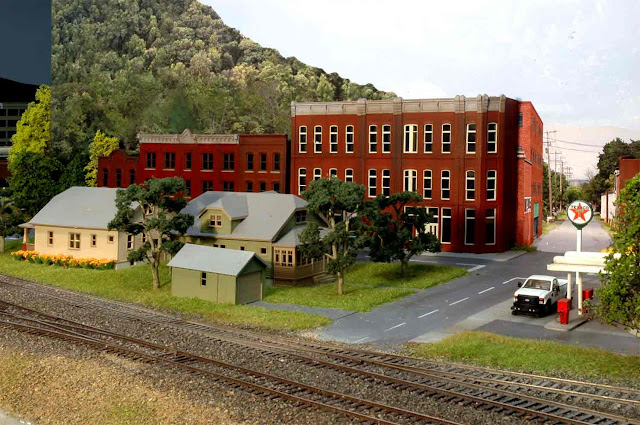Central Kentucky Grain
Work continues on the Central Kentucky Grain elevator at Bowling Green. Additional details have been added to include dust bins and a protective cover for loading covered hoppers during inclement weather. The loading chute on the right (uncovered) is for loading 40' boxcars. By the mid 1970's covered hoppers were the preferred means of shipping grain products. One covered hopper could carry twice as much as a 40' box car and they were easier to load and unload. But, due to light rail on some lines and a shortage of covered hoppers during the annual grain rush, box cars still made up about 30% of the fleet in 1975
The
interior of clean 40' box cars in grain service were lined, about
2/3rds of the way up, with cardboard. The doors were then closed off,
about 2/3rds of the way up, with cardboard "grain doors" or other
dunnage. The grain was then loaded to capacity (weight) with a flexible
duct. Many of these box cars were in dedicated grain service and "grain
loading only" was stenciled to their sides.
Athearn is scheduled to release a modernized 40' boxcar soon. Although I haven't been able to find a prototype photo of a L&N 40' boxcar in grain service, I think a couple of these should work.
Work has also progressed on the liquid fertilizer loading/unloading rack at the far end of elevator spur. Details include several storage tanks and a pump house.
After studying a older active elevator in Monroe, WA, I determined there should be a second elevator between the round "Butler" style storage bin and the main elevator. Although I think the Walthers version is a little crude, I decided to try it out. Once I had everything in place, I filled in around the complex with my initial layer of ground cover (paving sand).
A view looking east (south) of the completed model. It still need a few weeds and other details..
Reinhart Food Services
One of the things I learned during my recent trip to Kentucky, Tennessee and Northern Georgia is that things are much more spread out than I originally thought. This was particularly true around the rail yards in Madisonville and Bowling Green. The yards also tended to be smaller than I originally envisioned and were generally located outside the urban hubs.
Reinhart
Food Services is the first of several industries designed to represent a
more contemporary low rise industrial district southwest of downtown
Bowling Green. The facility handles frozen foods, perishables, and food
service related dry goods.
As you may recall, from the last post, this part of Preston Miller Yard in Bowling Green was dominated by four story cut stone building with a covered loading dock and a tilt-up style concrete addition. A portion of it shows up in the lead photo of the last update. The structure was actually better suited to a old industrial district in Chicago, Detroit or New York. It was also one of those rather distinctive Walthers kits that tend to show up on a lot of layouts; structures I try to avoid. And it had to go! Here is a photo Preston Miller Yard after I removed it.
Taken from about the same angle, Reinhart Food Services takes up about 4 linear feet. It still needs about 8 inches added to the end of the spur, a few details and some signage. The three tracks closest to the backdrop belong to the L&N. Preston Miller Yard, in the foreground, now belongs to the Southern/Central of Georgia. About a month ago, all of my private road equipment went into storage.
Reinhardt
was kit bashed from a couple of the recent Walthers tilt-up concrete
structures; primarily parts from the Modern Printing Plant 933-4079. Parts from the sides and back were spliced together to more than double the length. The office portion is about 1/2 inch thick. The warehouse/cold storage section is about 1 1/2 inch thick.
I like to switch out each new industry. L&N 1318 has picked up an empty PFE reefer from Reinhart, run around it, and is now headed west back to the small L&N yard on the west side of Bowling Green. The PFE is a 57' Athearn car. At one time I had 6 or 7 Intermontain PFE's. I decided they were to fragile for an operating layout so I sold them.
Here is an overall view of the complex including a second warehouse on the left. It was also built up using the same Walthers kit.
The Locomotive Facility at Preston Miller
I have been working my way around the lower level of the layout from east to west. I skipped over the locomotive servicing facility at Preston Miller while I agonized as to whether I should retain the turntable and roundhouse that were part of the original design, About a year ago I installed the turntable pit (110') but didn't progress beyond that point. To the relief of my grandson Adam, I have decided to maintain the turntable and add a roundhouse. Here is a current view of the complex. The turntable lead is in the foreground. The turntable and roundhouse will be just out of the photo on the right.

After looking at all the alternatives, including scratch or kit bashing, I decided to order a 4-stall version of the American Model Builders laser cut wood version to represent a roundhouse well past its prime. Brick is probably more typical of roundhouses in this part of the country but I really like the AMB model. I think it is a Missouri Pacific standard design. It should be here in about a week and I can't wait to get started on it. I will take pictures as I go through the building process and share them on a future post. Here is picture, from the AMB website, of the 2-stall version.
Your comments and/or suggestions are always welcome. Email me at sdepolo@outlook.com













































